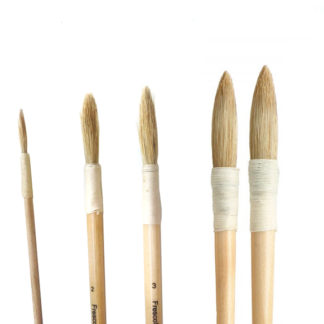Classic formulas for fresco plaster call for river sand. Why is that so? Is river sand really the best sand for fresco plaster?
Let’s get back to European history (as fresco painting was most prominent there) to the time when lime-based plasters were an all-around standard. Fresco painting and lime wash were the only techniques for painted building decoration.
That brings us to the Minoans, Ancient Greece and Rome – all marine cultures located in the middle of Mediterranean Sea which have plenty of easy-to-get sand at the beach, however that sand is not suitable for plaster. Salt is the enemy of plaster and ocean waves would tumble the sand particles making them round and smooth. Both of those factors will result in poor and weak plaster. Although salts can be washed out, the “roundness” of the sand particles can’t be remedied.
River Sand is predominantly a “young sand” crushed by geological movement and washed by fresh running water. Sharp, angular sand particles and the absence of salts make this sand perfect for any plaster, including fresco plaster. Common commercial sand for masonry and stucco work is either mined or industrially crushed from rocks. Mined sand is usually yellowish in color and the crushed sand is grayish.
FrescoShop.com offers Washed River Sand, sifted and ready for intonaco or arriccio plaster.
Fresco plaster is essentially a classic “stucco plaster” which is made with pure lime putty and the aggregate – most common is the sand (other aggregates). Depending on the application and the plaster coats it may include pozzolana (volcanic ash) or cocciopesto (brick dust). In conventional stucco the latter is replaced with Portland cement.
Washed, angular sand for stucco plaster and mortar can be found at most common building material stores and is labeled as “washed plaster sand” which is a common sand. If you can’t find a bag labeled as “Washed Plaster Sand” then “All Purpose Sand” is just fine.
Stay away from “Play Sand”, “Sand Blasting” or Silica sand – those sands are either sifted out to contain only a certain particle size or completely washed out of the “dust” – both of these factors will result in a weak crumbling plaster (see tutorial).
Regular sand, also known as feldspathic sand, brown sand, or construction sand, will always contain some silica, but only in amounts less than 95%. For example, typical brown sand used for concrete applications can contain up to 80% SiO2, along with varying amounts of iron, carbonate, potassium, and other trace elements/minerals. These ‘impurities’ make regular sand more chemically reactive and often darker in color when compared to silica sand.
Check out the video below to see where in Home Depot you can find “Regular Sand”:







